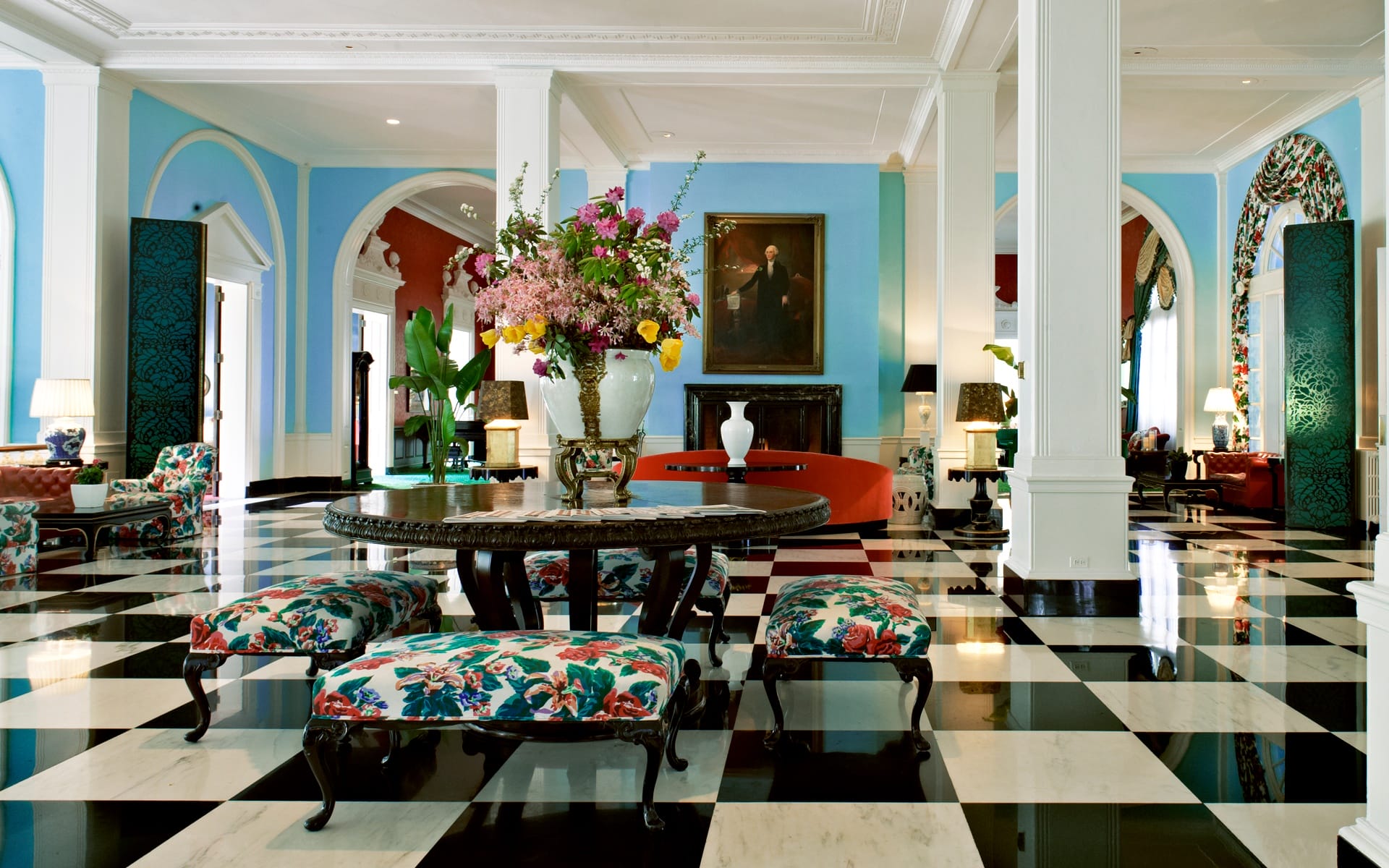Anatomy of a Room: Dorothy Draper’s Iconic Lobby for the Greenbrier
Discover why the storied West Virginia resort is widely regarded as the decorator’s masterpiece

The Greenbrier is perhaps the most famous project of Dorothy Draper, the pioneering decorator credited with mainstreaming the interior design profession in the early 20th century. Set on 11,000 woodland acres in West Virginia’s scenic Allegheny Mountains, the palatial resort dates to 1778 and was a magnet for members of high society looking for a retreat. The current building was constructed in 1913, but by the time Draper first laid eyes on the interiors in 1946, the massive hotel had been converted to an army hospital for soldiers during World War II.
Draper quickly got to work on what would become the largest redecorating project for a hotel that the country had ever seen, with her first order of business being the cavernous upper lobby. “Mrs. Draper was the one who opened up the spaces so you could see practically from one end of the hotel to the other,” says Draper protégé Carleton Varney, whose new book, Romance and Rhododendrons: My Love Affair with America’s Resort (Shannongrove Press), comes out in November. “The hotel is the largest thing ever decorated, and she was very proud of whole project.” Varney serves as president of Dorothy Draper & Co. Inc. and has periodically refreshed the Greenbrier, among other Draper interiors, over his five-decade tenure at the firm.
Here, Galerie pulls out the elements—from the floors to the wallpaper—that make the Greenbrier lobby so iconic.


Flooring
A Dorothy Draper trademark, the high-contrast checkerboard that paves the upper lobby is instantly eye-catching. “It’s a symbol of a lot of what she did,” says Varney of the oversize black Belgian and white Georgian marble pattern, which is set at a diagonal. “Mrs. Draper believed every room needed a touch of black anyway, and underfoot is a prominent way to display it.” However, the dramatic makeover—which replaced thick carpeting—was not without controversy. “It was a big contrast to the prewar look,” says Robert Conte, Greenbrier historian. “Some people thought it was too modern for a very traditional resort, but luckily more people loved than hated it.” Many Draper projects, including luxury apartment buildings on Fifth Avenue, have similar flooring that can still be seen today.

Walls
Often compared to Tiffany & Co.’s famous robin’s egg blue, the cheerful shade that Draper selected for the walls of the Greenbrier creates a romantic contrast to the chic marble floors. “She thought of it as Monticello blue,” says Varney, referencing Thomas Jefferson’s storied Virginia estate. The actual shade that sheathes the lobby, Carleton blue, is part of the Dorothy Draper/Carleton Varney Paint Collection and can be purchased from Fine Paints of Europe.

Furniture
The lobby’s sumptuous array of furnishings includes Draper’s original red wingback armchairs and kidney-shaped sofas, which were a modern look in the 1940s. “Mrs. Draper liked things that were round because they were huggable,” Varney tells Galerie. “The great thing is we have our own upholstery shop inside the Greenbrier, so the sofas have never changed.” For those itching to mimic the look in their own homes, the resort also has an on-site home design shop that sells all of the furnishings. “Anything you like in the lobby you can buy in the store.”

Art
“Mrs. Draper loved art,” says Varney, noting that the decorator counted artist Marcel Vertès among her close circle of friends. The upper lobby is bookended by two large works of art, including a copy of Gilbert Stuart’s famous portrait of George Washington (above) that was created by his daughter, Jane Stuart. “It captures the statesman George Washington, as opposed to him as a military man,” Conte adds, noting that there are other copies in the White House and the National Portrait Gallery. In the painting, the first president holds a scroll that says “Beware of Foreign Influence,” which is a departure from Gilbert’s original. The other artwork is also attributed to Gilbert Stuart, and though many assume it’s a portrait of Thomas Jefferson, the piece is titled Portrait of a Gentleman, and Conte does not believe the “gentleman” depicted is the third president.

Stairwell
Lined with Hollywood-style red carpet, the staircase walls are sheathed in two of French manufacturer Zuber’s wallpapers: “The American War for Independence” and “Views of North America.” The latter is also used at the White House.

Wallpaper
In the stairwell going down to the casino level and on a concourse called “Greenbrier Avenue,” Varney installed one of Draper’s most famous wallpaper designs: “Brazilliance,” a chic banana-leaf motif that she dreamed up for the Palácio Quitandinha hotel in Petrópolis, Brazil. Originally produced for Schumacher, the tropical pattern has become synonymous with the decorator—and it has inspired a legion of imitators. “Everybody has made a stab at copying it,” says Varney.
